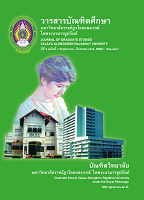การพัฒนารูปแบบการส่งเสริมศักยภาพความเป็นองค์การแห่งการเรียนรู้ ของโรงเรียนประถมศึกษาขนาดเล็ก A DEVELOPMENT OF MODEL FOR LEARNING ORGANIZATION CAPABILITY BUILDING OF SMALL SIZED PRIMARY SCHOOLS
Main Article Content
Abstract
บทคัดย่อ
การวิจัยครั้งนี้มีวัตถุประสงค์ 1) เพื่อศึกษาความเป็นองค์การแห่งการเรียนรู้ของโรงเรียนประถมศึกษาขนาดเล็ก 2) เพื่อวิเคราะห์ปัจจัยที่ส่งผลต่อความเป็นองค์การแห่งการเรียนรู้ของโรงเรียนประถมศึกษาขนาดเล็ก และ 3) เพื่อพัฒนารูปแบบการส่งเสริมศักยภาพความเป็นองค์การแห่งการเรียนรู้ของโรงเรียนประถมศึกษาขนาดเล็ก
วิธีดำเนินการวิจัย แบ่งออกเป็น 2 ขั้นตอน 1) ศึกษาระดับความเป็นองค์การแห่งการเรียนรู้และปัจจัยที่ส่งผลต่อความเป็นองค์การแห่งการเรียนรู้ของโรงเรียนประถมศึกษาขนาดเล็ก โดยใช้แบบสอบถามในการเก็บรวบรวมข้อมูลกับกลุ่มตัวอย่างในการวิจัย คือผู้บริหารโรงเรียนประถมศึกษาขนาดเล็ก สังกัดสำนักงานเขตพื้นที่การศึกษาประถมศึกษา จำนวน 375 คน 2) การพัฒนารูปแบบการส่งเสริมศักยภาพความเป็นองค์การแห่งการเรียนรู้ของโรงเรียนประถมศึกษาขนาดเล็ก โดยการจัดประชุมกลุ่มสนทนาผู้เชี่ยวชาญ จำนวน 9 คน ค่าสถิติที่ใช้ คือ ค่าร้อยละ ค่าเฉลี่ย ค่าส่วนเบี่ยงเบนมาตรฐาน การวิเคราะห์ ค่าสัมประสิทธิ์การถดถอยพหุคูณแบบขั้นตอน การวิเคราะห์เนื้อหา และ การวิเคราะห์สรุปอุปนัย
ผลการวิจัยพบว่า
1. ความเป็นองค์การแห่งการเรียนรู้ของโรงเรียนประถมศึกษาขนาดเล็กในภาพรวมอยู่ในระดับมาก และเมื่อพิจารณาเป็นรายด้าน พบว่า ทุกด้านอยู่ในระดับมาก
2. ปัจจัยที่ส่งผลต่อความเป็นองค์การแห่งการเรียนรู้ของโรงเรียนประถมศึกษาขนาดเล็ก อย่างมีนัยสำคัญทางสถิติที่ระดับ .05 ประกอบด้วย 6 ปัจจัย โดยเรียงลำดับจากมากไปหาน้อย ดังนี้ การสร้างวิสัยทัศน์ พันธกิจและยุทธศาสตร์ (X1) การพัฒนาบุคลากรและทีมงาน (X7) การจัดการความรู้ (X3) การนำเทคโนโลยีไปประยุกต์ใช้ (X4) การจัดโครงสร้างการบริหารงาน (X2) และการมีภาวะผู้นำทางวิชาการ (X5) ซึ่งทั้ง 6 ปัจจัยนี้ร่วมกันพยากรณ์ความเป็นองค์การแห่งการเรียนรู้ของโรงเรียนประถมศึกษาขนาดเล็ก ได้ร้อยละ 57.60 เขียนเป็นสมการพยากรณ์ ได้ดังสมการ
2.1 ในรูปคะแนนดิบ
Y = 0.742 + 0.195 (X3) + 0.348 (X1) + 0.224 (X7) +0.135 (X4) - 0.183 (X5) + 0.095 (X2)
2.2 ในรูปคะแนนมาตรฐาน
Z’y = 0.213 Z3 + 0.353 Z1 + 0.265 Z7 + 0.144 Z4 - 0.185 Z5 + 0.110 Z2
3. การพัฒนารูปแบบการส่งเสริมศักยภาพความเป็นองค์การแห่งการเรียนรู้ของโรงเรียนประถมศึกษาขนาดเล็ก ประกอบด้วย 2 ส่วน คือปัจจัยหลัก 6 ปัจจัย ได้แก่ การสร้างวิสัยทัศน์ พันธกิจ และยุทธศาสตร์ การพัฒนาบุคลากรและทีมงาน การจัดการความรู้ การนำเทคโนโลยีไปประยุกต์ใช้ การจัดโครงสร้างการบริหารงาน และการมีภาวะผู้นำทางวิชาการ และปัจจัยส่งเสริม 4 ปัจจัย ประกอบด้วย MANO ได้แก่ การขับเคลื่อนร่วมกัน (Move together) การสร้างความตระหนักรู้ (Awareness) การทำงานเป็นทีม (Never do alone) และการรวมใจเป็นหนึ่งเดียว (One for all, all for one) และองค์ประกอบย่อยของปัจจัยหลักและปัจจัยส่งเสริม จำนวน 36 องค์ประกอบย่อยที่มีความสัมพันธ์เชื่อมโยงกัน
การบริหารจัดการรูปแบบการส่งเสริมศักยภาพความเป็นองค์การแห่งการเรียนรู้ของโรงเรียนประถมศึกษาขนาดเล็ก ใช้หลัก PDCA ได้แก่หลักการวางแผน (Plan) หลักการปฏิบัติ (Do) หลักการตรวจสอบ (Check) และหลักการปรับปรุง/แก้ไข (Act)
ABSTRACT
The purposes of this research were; 1) to study the levels of learning organization of small sized primary schools. ; 2) to analyze factors affecting of knowledge sharing of learning organization of small sized primary schools. ; and 3) to development model for learning organization capability building of small sized primary schools.
The research methodology was devided in to two steps. The first step was to study the levels and analyze factors affecting by using the questionnaires for data collection. The sample was 375 administrators from the small sized primary schools Under Primary Education Service Area Office. The second step was to development model for learning organization capability building of small sized primary school by Focus Group Discussion with nine experts. Questionnaires were used for data collection. The data were analyzed with percentage, Arithmetic mean, Standard Deviation, Stepwise Multiple Regression Analysis, Content analysis and analytic induction.
The research finding were;:
1. The levels of learning organization of small sized primary schools was at the more levels.
2. The affecting factors on the learning organization of small sized primary schools ranking from the most to the least were Vision mission and strategies (X1), Personnel and teamwork development(X7), Knowledge management (X3), Technology application (X4), Structure administration (X2), and Instructional leadership (X5) with were statistical significant at .05 level. All 6 factors were together as a predictor for 58.00 percents. Thus it could be in a equations of factors affecting on the learning organization of small sized primary schools were as follows:
2.1 The predicted equation in terms of raw scores was:
Y = 0.742 + 0.195 (X3) + 0.348 (X1) + 0.224 (X7) + 0.135 (X4) ) - 0.183 (X5) + 0.095 (X2) 2.2 The predicted equation in terms of standards scores was:
Z’y = 0.213 Z3 + 0.353 Z1 + 0.265 Z7 + 0.144 Z4 - 0.185 Z5 + 0.110 Z2
3. Model for learning organization capability building of small sized primary schools, consisted of 6 core factors: Vision mission and strategies, Personnel and teamwork development, Knowledge management, Technology Application, Structure administration, and Instructional leadership. And 4 support factors: MANO were Move together: M, Awareness: A, Never do alone: N, One for all, all for one : O. Furthermore, these 6 core factors and 4 support factors also consisted of 36 subcomponents with were correlated to each other’s.
The administrative model for learning organization capability building of small sized primary schools., were to Plan, Do, Check, Act.
Article Details

This work is licensed under a Creative Commons Attribution-NonCommercial-NoDerivatives 4.0 International License.
บทความทุกเรื่องได้รับการตรวจความถูกต้องทางวิชาการโดยผู้ทรงคุณวุฒิ ทรรศนะและข้อคิดเห็นในบทความ Journal of Global of Perspectives in Humanities and Social Sciences (J-GPHSS) มิใช่เป็นทรรศนะและความคิดของผู้จัดทำจึงมิใช่ความรับผิดชอบของบัณฑิตวิทยาลัย มหาวิทยาลัยราชภัฏวไลยอลงกรณ์ ในพระบรมราชูปถัมภ์ กองบรรณาธิการไม่สงวนสิทธิ์การคัดลอก แต่ให้อ้างอิงแหล่งที่มา


